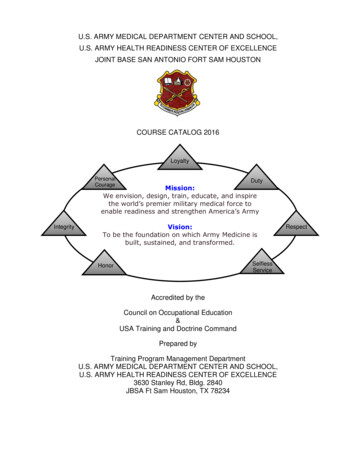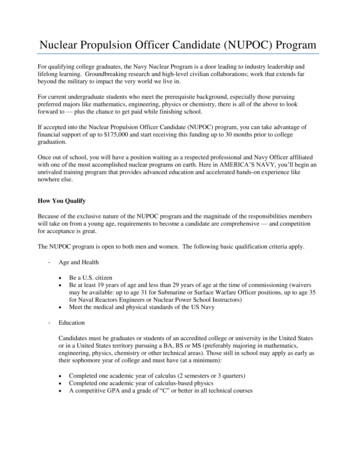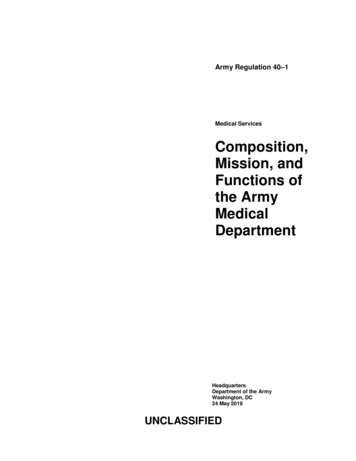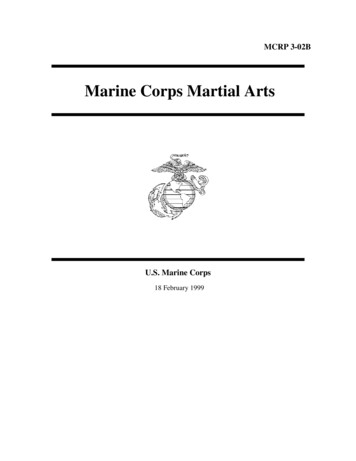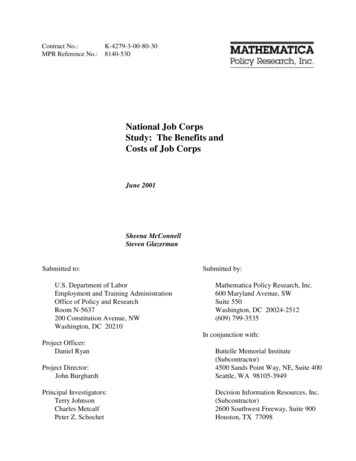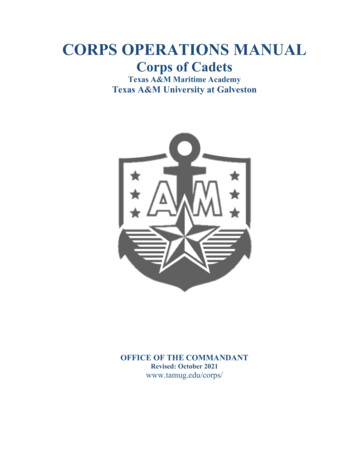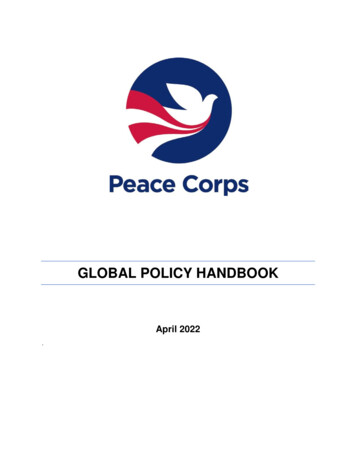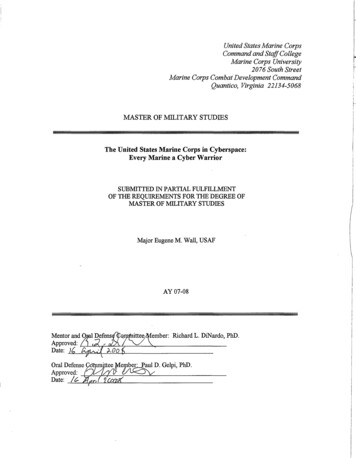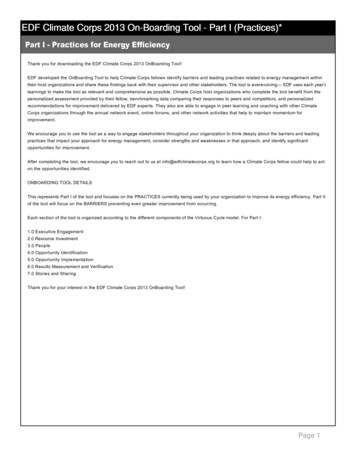
Transcription
EDF Climate Corps 2013 On-Boarding Tool - Part I (Practices)*Part I Practices for Energy EfficiencyThank you for downloading the EDF Climate Corps 2013 OnBoarding Tool!EDF developed the OnBoarding Tool to help Climate Corps fellows identify barriers and leading practices related to energy management withintheir host organizations and share these findings back with their supervisor and other stakeholders. The tool is everevolving— EDF uses each year’slearnings to make the tool as relevant and comprehensive as possible. Climate Corps host organizations who complete the tool benefit from thepersonalized assessment provided by their fellow, benchmarking data comparing their responses to peers and competitors, and personalizedrecommendations for improvement delivered by EDF experts. They also are able to engage in peer learning and coaching with other ClimateCorps organizations through the annual network event, online forums, and other network activities that help to maintain momentum forimprovement.We encourage you to use the tool as a way to engage stakeholders throughout your organization to think deeply about the barriers and leadingpractices that impact your approach for energy management, consider strengths and weaknesses in that approach, and identify significantopportunities for improvement.After completing the tool, we encourage you to reach out to us at info@edfclimatecorps.org to learn how a Climate Corps fellow could help to acton the opportunities identified.ONBOARDING TOOL DETAILSThis represents Part I of the tool and focuses on the PRACTICES currently being used by your organization to improve its energy efficiency. Part IIof the tool will focus on the BARRIERS preventing even greater improvement from occurring.Each section of the tool is organized according to the different components of the Virtuous Cycle model. For Part I:1.0 Executive Engagement2.0 Resource Investment3.0 People4.0 Opportunity Identification5.0 Opportunity Implementation6.0 Results Measurement and Verification7.0 Stories and SharingThank you for your interest in the EDF Climate Corps 2013 OnBoarding Tool!Page 1
EDF Climate Corps 2013 On-Boarding Tool - Part I (Practices)*1.0 Executive EngagementPlease answer the following questions regarding the organization's practices related to engaging its "Executive Team" toimprove energy efficiency.The "Executive Team" designation generally refers to the very top group of organizational leaders who are responsible foroverall strategy setting and decision making. For example, in private sector companies the "Executive Team" refers tothe C Suite Level Executives. For government, nonprofit, and university organizations, the "Executive Team" refers to thetop administrative/management team of the organization.Total floor space (square feet):Annual total electricity use (kWh):Annual total non electricity energy use (BTUs):Add any notes regarding your calculations of floor space or energy use:561. Does our Executive Team contain members with roles or responsibilities for improvingorganizational energy efficiency?j No, and we have no plans in place to create such roles or responsibilities within the next three yearsklmnj No, but we have plans in place to create such roles or responsibilities within the next three yearsklmnj Yes, but these are voluntary or informal roles onlyklmnj Yes, formal roles or responsibilities, but they are not incentivized or compensated (e.g., formal recognition, performance evaluation,klmnbonus, etc.) for improvements createdj Yes, formal roles or responsibilities, and they are incentivized or compensated (e.g., formal recognition, performance evaluation, bonus,klmnetc.) for improvements createdj Don't knowklmnPage 2
EDF Climate Corps 2013 On-Boarding Tool - Part I (Practices)*2. Does our organization benchmark (i.e., compare and contrast) its energy practicesand/or performance with those of principal competitors, corporate sustainability leaders,or energy management standards?j No, and we have no plans in place to benchmark within the next three yearsklmnj No, but we have plans in place to benchmark within the next three yearsklmnj Yes, but we have only done so once or a few timesklmnj Yes, and we do this every few years as necessaryklmnj Yes, and we do this most years or every yearklmnj Don't knowklmn3. Has our Executive Team established an energy reduction strategy? What bestdescribes the nature of this strategy?j No, and we have no plans in place to create a strategy within the next three yearsklmnj No, but we have plans in place to create a strategy within the next three yearsklmnj Yes, for parts of our organization, but it is not organization wideklmnj Yes, for our entire organization, but we do not review this strategy on at least an annual basisklmnj Yes, for our entire organization, and we review this strategy on at least an annual basisklmnj Don't knowklmn4. Has our Executive Team established a greenhouse gas reduction strategy? What bestdescribes the nature of this strategy?j No, and we have no plans in place to create a strategy within the next three yearsklmnj No, but we have plans in place to create a strategy within the next three yearsklmnj Yes, for parts of our organization, but it is not organization wideklmnj Yes, for our entire organization, but we do not review this strategy on at least an annual basisklmnj Yes, for our entire organization, and we review this strategy on at least an annual basisklmnj Don't knowklmnPage 3
EDF Climate Corps 2013 On-Boarding Tool - Part I (Practices)*5. Has our Executive Team established energy reduction goals? What best describes thenature of these goals?j No, and we have no plans in place to create goals within the next three yearsklmnj No, but we have plans in place to create goals within the next three yearsklmnj Yes, but they are not organization wideklmnj Yes, we have established intensity based (e.g., per dollar revenue, per employee, etc.) reduction goals for our entire organizationklmnj Yes, we have established absolute reduction goals for our entire organizationklmnj Don't knowklmn6. Has our Executive Team established greenhouse gas reduction goals? What bestdescribes the nature of these goals?j No, and we have no plans in place to create goals within the next three yearsklmnj No, but we have plans in place to create goals within the next three yearsklmnj Yes, but they are not organization wideklmnj Yes, we have established intensity based (e.g., per dollar revenue, per employee, etc.) reduction goals for our entire organizationklmnj Yes, we have established absolute reduction goals for our entire organizationklmnj Don't knowklmnPage 4
EDF Climate Corps 2013 On-Boarding Tool - Part I (Practices)*Executive Engagement Continued7. Has our Executive Team established metrics for measuring energy efficiencyimprovement? What best describes the nature of these metrics?j No, and we have no plans in place to create such metrics within the next three yearsklmnj No, but we have plans in place to create such metrics within the next three yearsklmnj Yes, for parts of our organization, but they are not organization wideklmnj Yes, for our entire organization, but they are not being consistently usedklmnj Yes, for our entire organization, and they are being consistently usedklmnj Don't knowklmn8. Has our Executive Team established metrics for measuring greenhouse gasreductions? What best describes the nature of these metrics?j No, and we have no plans in place to create such metrics within the next three yearsklmnj No, but we have plans in place to create such metrics within the next three yearsklmnj Yes, for parts of our organization, but they are not organization wideklmnj Yes, for our entire organization, but they are not being consistently usedklmnj Yes, for our entire organization, and they are being consistently usedklmnj Don't knowklmn9. How often does our organization present specific energy efficiency investment ideasand/or plans to our Executive Team?j Neverklmnj Annually or less frequentlyklmnj Quarterlyklmnj Monthlyklmnj Weekly or more frequentlyklmnj Don't knowklmnPage 5
EDF Climate Corps 2013 On-Boarding Tool - Part I (Practices)*10. Does our Executive Team consider co benefits to improved energy efficiency beyondcost savings (e.g., better brand value, improved environmental performance, improvedemployee morale, increased productivity, etc.) in decision making?j No, co benefits are not well understood or consideredklmnj No, co benefits are understood, but not consideredklmnj Yes, but only informally and do not significantly influence decision makingklmnj Yes, formally considered and can sometimes influence decision makingklmnj Yes, formally considered and frequently influence decision makingklmnj Don't knowklmn11. Does our Executive Team consider risks associated with escalating energy pricegrowth in decision making?j No, these risks are not well understood or consideredklmnj No, these risks are understood, but not consideredklmnj Yes, but only informally and do not significantly influence decision makingklmnj Yes, formally considered and can sometimes influence decision makingklmnj Yes, formally considered and frequently influence decision makingklmnj Don't knowklmn12. Who was interviewed in order to answer these questions?Name 1Position/Title 1Name 2Position/Title 2Name 3Position/Title 3Page 6
EDF Climate Corps 2013 On-Boarding Tool - Part I (Practices)*2.0 Resource InvestmentPlease answer the following questions regarding the organization's practices related to "Resource Investment" to improveenergy efficiency.13. Does our organization utilize 'green' leases that align our incentives with those of thelandlord to ensure efficiency investments can occur in our buildings?j No, we do not use leases because we own most or all of our buildingsklmnj No, we lease most or all of our buildings, but do not utilize 'green' leasesklmnj No, but we have plans in place to utilize them within the next three yearsklmnj Yes, but only in fewer than a quarter of our buildingsklmnj Yes, but only in fewer than half of our buildingsklmnj Yes, in the majority or all of our buildingsklmnj Don't knowklmn14. Are departments that use energy responsible for paying for that energy from their ownbudgets?j No, and it would not be possible to structure budgets in this wayklmnj No, but it would be possible to structure budgets in this wayklmnj Yes, but only for less than a quarter of our total energy spendklmnj Yes, but only for less than half our total energy spendklmnj Yes, for the majority or all of our total energy spendklmnj Don't knowklmn15. Does our equipment procurement department consider total cost of ownership (TCO),including energy costs, when making purchasing decisions?j No, total cost of ownership is not well understood or consideredklmnj No, total cost of ownership is understood, but not consideredklmnj Yes, but only informally and does not significantly influence purchasing decisionsklmnj Yes, formally considered and can sometimes influence purchasing decisionsklmnj Yes, formally considered and frequently influences purchasing decisionsklmnj Don't knowklmnPage 7
EDF Climate Corps 2013 On-Boarding Tool - Part I (Practices)*16. Are departments that pay for energy efficiency investments able to recoup the cost savings that those investments generate?j No, and it would not be possible to structure budgets in this wayklmnj No, but it would be possible to structure budgets in this wayklmnj Yes, but they are only able to recoup less than a quarter of the cost savingsklmnj Yes, but they are only able to recoup less than half of the cost savingsklmnj Yes, and they are able to recoup the majority or all of the cost savingsklmnj Don't knowklmn17. Has our organization hired one or more individuals with explicit responsibilities tocoordinate and fund energy efficiency investments across the organization?j No, and we have no plans in place to hire such an individual within the next three yearsklmnj No, but we have plans in place to hire such an individual within the next three yearsklmnj Yes, but less than a quarter of this individual's responsibilities or time relate directly to coordinating and funding energy efficiencyklmninvestmentsj Yes, but less than half of this individual's responsibilities or time relate directly to coordinating and funding energy efficiency investmentsklmnj Yes, and a majority or all of this individual's responsibilities or time relate directly to coordinating and funding energy efficiencyklmninvestmentsj Don't knowklmnPage 8
EDF Climate Corps 2013 On-Boarding Tool - Part I (Practices)*Resource Investment Continued18. Which of the following financial measurements do decision makers generally use tomake investment decisions, including those related to energy efficiency?c Return on Investment (ROI) (%)defgc Internal Rate of Return (IRR) (%)defgc Hurdle Rate (%)defgc None of thesedefgc Don't knowdefg19. For each financial measurement used in investment decision making, please providethe typical threshold value that investments must achieve in order to receive funding.Return on Investment (ROI) (%)Internal Rate of Return (IRR) (%)Hurdle Rate (%)20. Do decision makers impose a payback requirement on energy efficiency projects? Ifso, what is the longest payback acceptable under this requirement?j Yes, and paybacks must be shorter than 2 years to receive fundingklmnj Yes, and paybacks must be shorter than 3 years to receive fundingklmnj Yes, and paybacks must be shorter than 4 years to receive fundingklmnj Yes, but our payback requirement is longer than 4 yearsklmnj No, we do not impose a specific payback requirement to receive fundingklmnj Don't knowklmn21. Do decision makers consider the net present value (NPV) of a project when makinginvestment decisions, including those related to energy efficiency?j No, net present value is not well understood or consideredklmnj No, net present value is understood, but not consideredklmnj Yes, but only informally and does not significantly influence decision makingklmnj Yes, formally considered and can sometimes influence decision makingklmnj Yes, formally considered and frequently influences decision makingklmnj Don't knowklmnPage 9
EDF Climate Corps 2013 On-Boarding Tool - Part I (Practices)*22. Do decision makers consider energy price growth expectations when makinginvestment decisions, including those related to energy efficiency?j No, energy price growth expectations are not well understood or consideredklmnj No, energy price growth expectations are understood, but not consideredklmnj Yes, but are not incorporated in financial calculations and do not significantly influence investment decisionsklmnj Yes, formally incorporated in financial calculations and can sometimes influence investment decisionsklmnj Yes, formally incorporated in financial calculations and frequently influence investment decisionsklmnj Don't knowklmnPage 10
EDF Climate Corps 2013 On-Boarding Tool - Part I (Practices)*Resource Investment Continued23. Does our organization consider environmental key performance indicators (KPIs)when making investment decisions, including those related to energy efficiency?j No, environmental KPIs are not established or consideredklmnj No, environmental KPIs are established, but not consideredklmnj Yes, but only informally and do not significantly influence decision makingklmnj Yes, formally considered and can sometimes influence decision makingklmnj Yes, formally considered and frequently influence decision makingklmnj Don't knowklmn24. Do decision makers consider the greenhouse gas emissions reductions associatedwith a project when making investment decisions, including those related to energyefficiency?j No, greenhouse gas emissions are not well understood or consideredklmnj No, greenhouse gas emissions are understood, but not consideredklmnj Yes, but only informally and do not significantly influence decision makingklmnj Yes, formally considered and can sometimes influence decision makingklmnj Yes, formally considered and frequently influence decision makingklmnj Don't knowklmn25. Does our organization invest in diversified portfolios of energy efficiency investmentsrather than on a case by case basis?j No, portfolio approaches to energy efficiency investments are not well understood or utilizedklmnj No, portfolio approaches to energy efficiency investments are understood, but not utilizedklmnj Yes, but less than a quarter of energy efficiency investments are made through a portfolio approachklmnj Yes, but less than half of energy efficiency investments are made through a portfolio approachklmnj Yes, a majority or all energy efficiency investments are made through a portfolio approachklmnj Don't knowklmnPage 11
EDF Climate Corps 2013 On-Boarding Tool - Part I (Practices)*26. Does our organization maintain a dedicated pool of funding for energy efficiencyinvestments?j No, and we have no plans in place to establish a dedicated fund within the next three yearsklmnj No, but we have plans in place to establish a dedicated fund within the next three yearsklmnj Yes, but the fund is inconsistent and is sometimes cut depending on the yearklmnj Yes, and the funding is consistently replenished by an external budget each yearklmnj Yes, and the fund is self replenishing, with cost savings from one year being used to pay for future years' investmentsklmnj Don't knowklmn27. Does our organization allow the use of utility and/or government rebates andincentives to fund capital improvement projects, including those related to energyefficiency?j No, and we have no plans in place to allow their use within the next three yearsklmnj No, but we have plans in place to allow their use within the next three yearsklmnj Yes, but have chosen not to do so because of disadvantages or difficulties associated with their useklmnj Yes, and have used them in the past, but will not likely use them again in the futureklmnj Yes, we have used them in the past, and intend to use them again in the futureklmnj Don't knowklmnPage 12
EDF Climate Corps 2013 On-Boarding Tool - Part I (Practices)*Resource Investment Continued28. Does our organization allow the use of external financing (e.g., loans from banks,service providers, etc.) to fund capital improvement projects, including those related toenergy efficiency?j No, and we have no plans in place to allow it within the next three yearsklmnj No, but we have plans in place to allow it within the next three yearsklmnj Yes, but have chosen not to do so because of disadvantages or difficulties associated with its useklmnj Yes, and we have used it in the past, but will not likely use it again in the futureklmnj Yes, we have used it in the past, and intend to use it again in the futureklmnj Don't knowklmn28a. Does our organization currently have access to affordable capital for energyupgrades?j No, our organization does not currently have access to affordable capital for energy upgradesklmnj No, but we expect to have access to affordable capital for energy upgrades within the next three yearsklmnj Yes, but this access is inconsistent and only sometimes availableklmnj Yes, our organization always has access to affordable capital for energy upgrades, but we choose not to utilize itklmnj Yes, our organization always has access to affordable capital for energy upgrades and we utilize itklmnj Don’t knowklmn28b. Is access to affordable capital an important consideration in deciding whether topursue energy upgrade projects?j No, access to capital is not a considerationklmnj No, access to capital is only a minor considerationklmnj Yes, access to capital is a moderately important considerationklmnj Yes, access to capital is an important considerationklmnj Yes, access to capital is a very important considerationklmnj Don’t knowklmnPage 13
EDF Climate Corps 2013 On-Boarding Tool - Part I (Practices)*28c. Would our organization be more likely to pursue energy upgrades if externalfinancing were available in the form of a service agreement rather than on balance sheetdebt?j No, our organization would be even less likely to pursue energy upgradesklmnj No, our organization would be just as likely to pursue energy upgradesklmnj Yes, our organization would be slightly more likely to pursue energy upgradesklmnj Yes, our organization would be more likely to pursue energy upgradesklmnj Yes, our organization would be much more likely to pursue energy upgradesklmnj Don’t knowklmn28d. What does our organization see as key barriers to accessing affordable capital forenergy upgrades?5629. Does our organization track the total dollars invested in energy efficiency projectseach year?j No, and we have no plans in place to begin tracking dollars invested within the next three yearsklmnj No, but we have plans in place to begin tracking dollars invested within the next three yearsklmnj Yes, but dollars invested in less than a quarter of energy efficiency investments are effectively trackedklmnj Yes, but dollars invested in less than half of energy efficiency investments are effectively trackedklmnj Yes, and dollars invested in a majority or all energy efficiency investments are effectively trackedklmnj Don't knowklmn30. Does our organization track the cost savings generated by energy efficiency projectsafter they have been implemented?j No, and we have no plans in place to begin tracking savings within the next three yearsklmnj No, but we have plans in place to begin tracking savings within the next three yearsklmnj Yes, but savings generated by less than a quarter of energy efficiency investments are effectively trackedklmnj Yes, but savings generated by less than half of energy efficiency investments are effectively trackedklmnj Yes, and savings for a majority or all energy efficiency investments are effectively trackedklmnj Don't knowklmnPage 14
EDF Climate Corps 2013 On-Boarding Tool - Part I (Practices)*31. Who was interviewed in order to answer these questions?Name 1Position/Title 1Name 2Position/Title 2Name 3Position/Title 3Page 15
EDF Climate Corps 2013 On-Boarding Tool - Part I (Practices)*3.0 PeoplePlease answer the following questions regarding the organization's practices related to increasing the capability andmotivation of "People" working to improve energy efficiency.32. Has our organization engaged its employees to explain, discuss, and beginimplementing its energy reduction strategy?j No, an energy reduction strategy has not been established and/or consideredklmnj No, we have a strategy, but have not yet engaged employees in these waysklmnj Yes, but we have engaged less than a quarter of employees in these waysklmnj Yes, but we have engaged less than half of employees in these waysklmnj Yes, and we have engaged a majority or all employees in these waysklmnj Don't knowklmn33. Has our organization engaged its employees to explain, discuss, and beginimplementing its greenhouse gas reduction strategy?j No, a greenhouse gas reduction strategy has not been established and/or consideredklmnj No, we have a strategy, but have not yet engaged employees in these waysklmnj Yes, but we have engaged less than a quarter of employees in these waysklmnj Yes, but we have engaged less than half of employees in these waysklmnj Yes, and we have engaged a majority or all employees in these waysklmnj Don't knowklmn34. Has our organization engaged its employees to explain, discuss, and beginimplementing its energy reduction goals?j No, energy reduction goals have not yet been established and/or consideredklmnj No, we have goals, but have not yet engaged employees in these waysklmnj Yes, but we have engaged less than a quarter of employees in these waysklmnj Yes, but we have engaged less than half of employees in these waysklmnj Yes, and we have engaged a majority or all employees in these waysklmnj Don't knowklmnPage 16
EDF Climate Corps 2013 On-Boarding Tool - Part I (Practices)*35. Has our organization engaged its employees to explain, discuss, and beginimplementing its greenhouse gas reduction goals?j No, greenhouse gas reduction goals have not yet been established and/or consideredklmnj No, we have goals, but have not yet engaged employees in these waysklmnj Yes, but we have engaged less than a quarter of employees in these waysklmnj Yes, but we have engaged less than half of employees in these waysklmnj Yes, and we have engaged a majority or all employees in these waysklmnj Don't knowklmn36. Has our organization established recruiting strategies and/or recruiting goals forincreasing the quantity and quality of energy professionals brought in as new employees?j No, and we have no plans in place to establish recruiting strategies or goals within the next three yearsklmnj No, but we have plans in place to establish recruiting strategies or goals within the next three yearsklmnj Yes, but these strategies and/or goals are only for certain parts of the organizationklmnj Yes, we have established a recruiting strategy for our entire organization, but have not established associated goalsklmnj Yes, we have established a recruiting strategy for our entire organization, with associated goalsklmnj Don't knowklmnPage 17
EDF Climate Corps 2013 On-Boarding Tool - Part I (Practices)*People Continued37. Has our organization hired one or more individuals with explicit responsibilities toidentify and ensure implementation of energy efficiency projects across the organization?j No, and we have no plans in place to hire such an individual within the next three yearsklmnj No, but we have plans in place to hire such an individual within the next three yearsklmnj Yes, but less than a quarter of this individual's responsibilities or time relates directly to identifying and implementing energy efficiencyklmninvestmentsj Yes, but less than half of this individual's responsibilities or time relates directly to identifying and implementing energy efficiencyklmninvestmentsj Yes, and a majority or all of this individual's responsibilities or time relates directly to identifying and implementing energy efficiencyklmninvestmentsj Don't knowklmn38. Does our organization incorporate energy efficiency tasks and deliverables intoemployee work plans?j No, and we have no plans to incorporate such tasks and deliverables into employee work plans within the next three yearsklmnj No, but we have plans to incorporate such tasks and deliverables into employee work plans within the next three yearsklmnj Yes, but we have incorporated such tasks and deliverables into less than a quarter of employee work plansklmnj Yes, but we have incorporated such tasks and deliverables into less than half of employee work plansklmnj Yes, and we have incorporated such tasks and deliverables into a majority or all employee work plansklmnj Don't knowklmn39. Does our organization form teams to advance and implement on going energyefficiency initiatives and projects?j No, and we have no plans to form such teams within the next three yearsklmnj No, but we have plans to form such teams within the next three yearsklmnj Yes, but these teams do not include stakeholders from across the organization and do not have significant organizational leadershipklmnrepresentedj Yes, these teams include stakeholders from across the organization, but do not have significant organizational leadership representedklmnj Yes, these teams include stakeholders from across the organization, and have significant organizational leadership representedklmnj Don't knowklmnPage 18
EDF Climate Corps 2013 On-Boarding Tool - Part I (Practices)*40. Does our organization provide access to training and other educational resources foremployees to become more capable and motivated to improve energy efficiency?j No, and we have no plans to provide access to these resources within the next three yearsklmnj No, but we have plans in place to provide access to these resources within the next three yearsklmnj Yes, but employees are not incentivized to utilize these resourcesklmnj Yes, employees are incentivized to utilize these resources, but do not generally do soklmnj Yes, employees are incentivized to utilize these resources, and generally do soklmnj Don't knowklmn41. Does our organization incentivize employees to reduce their personal energy use andotherwise improve the energy efficiency of the organization?j No, and we have no plans to offer incentives within the next three yearsklmnj No, but we have plans to offer incentives within the next three yearsklmnj Yes, we informally encourage employees with their efforts, but do not offer formal recognition or additional compensation (e.g.,klmnperformance evaluation, salary raise, bonus, etc.)j Yes, we formally recognize employees for their efforts, but do not offer additional compensation (e.g., performance evaluation, salaryklmnraise, bonus, etc.)j Yes, we formally recognize employees for their efforts and/or offer additional compensation (e.g., performance evaluation, salary raise,klmnbonus, etc.)j Don't knowklmn42. Who was interviewed in order to answer these questions?Name 1Position/Title 1Name 2Position/Title 2Name 3Position/Title 3Page 19
EDF Climate Corps 2013 On-Boarding Tool - Part I (Practices)*4.0 Opportunity IdentificationPlease answer the following questions regarding the organization's practices related to "Identifying" energy efficiencyimprovement opportunities.43. Does our organization keep centralized records of its equipment inventory and howmuch energy that equipment should be using under normal operating procedures?j No, and we have no plans in place to record such information within the next three yearsklmnj No, but we have plans in place to record such information within the next three yearsklmnj Yes, but such information is recorded for less than a quarter of our equipmentklmnj Yes, but such information is recorded for less than half of our equipmentklmnj Yes, a
EDF developed the OnBoarding Tool to help Climate Corps fellows identify barriers and leading practices related to energy management within their host organizations and share these findings back with their supervisor and other stakeholders. The tool is everevolving— EDF uses each year's learnings to make the tool as relevant and .
